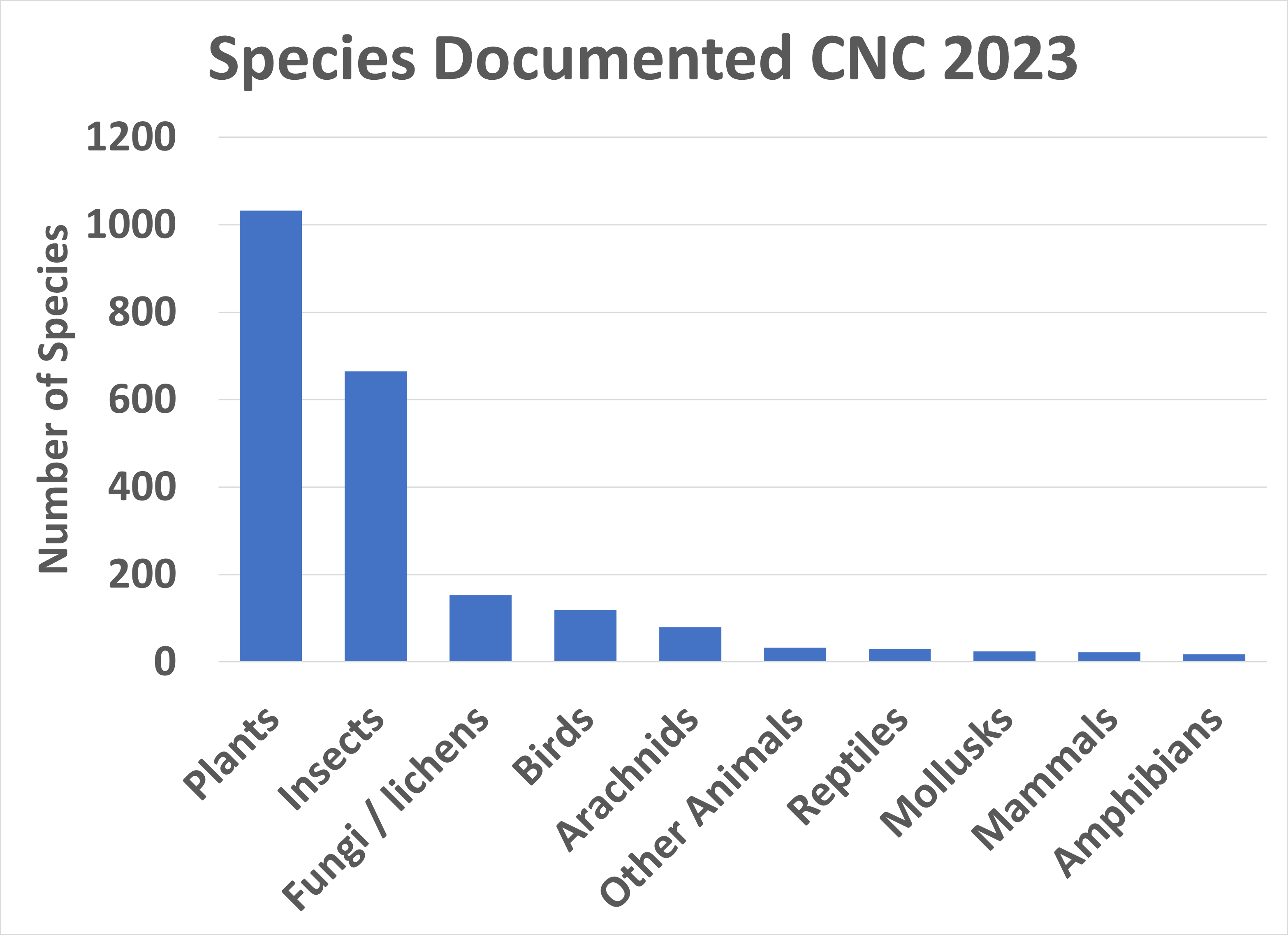Results Are In for the 2023 City Nature Challenge!
For immediate release ‐ May 12, 2023
Citizen Science
Contact: Chris Goforth, 919.707.8882 and Micah Beasley, 919.707.9970. Images available upon request
 Photos taken by 2023 City Nature Challenge participants. Pictured left to right: margined calligrapher (a type of hover fly), purple martins, and a Piedmont ghost firefly female.
Photos taken by 2023 City Nature Challenge participants. Pictured left to right: margined calligrapher (a type of hover fly), purple martins, and a Piedmont ghost firefly female.
By Chris Goforth, NCMNS Head of Citizen Science
The City Nature Challenge (CNC) took place April 28–May 1, 2023, and the Museum joined in the fun once again! This international event saw people in 482 cities in 46 countries documenting their local biodiversity through photos and sounds shared through the iNaturalist platform over the four-day event. A whopping 1.8 million observations of 57,000 species were made by 66,000 people who participated in the event worldwide!
The Museum oversees the Triangle Area region of North Carolina for the CNC, a 20-county area in the central part of the state. Triangle Area participants have been enthusiastic about the challenge since we first took part in 2017 and this year was no exception! We finished the 2023 CNC strong, with 761 people contributing 13,896 observations of 2,199 species. This is a small improvement over last year’s 13,364 observations of 2,155 species, despite the cool, rainy and windy conditions.
The CNC organizers rank cities based on their total number of observations, species, and participants. The Triangle Area ranked 32nd out of 482 cities, but we jumped to 23rd for species and 16th for participants.
As usual, plants dominated the species documented in the Triangle Area and represented 47% of the total species observed in 2023. Insects were a relatively close second at 30%, but fungi came in third at only 7%. As you can see in the graph below, most taxa made up only small percentages of the total species documented, though this is not unusual. Most iNaturalist contributors, and not just during the CNC, take photos with their phones and phone cameras have limitations documenting things like birds and mammals that must be photographed from far away to avoid scaring the animal away. Plant species are consistently the most heavily represented in iNaturalist, largely due to their immobility.
 Graph illustrating the total number of species reported for each of iNaturalist’s major taxa.
Graph illustrating the total number of species reported for each of iNaturalist’s major taxa.
While we work hard to make this event a success locally, we also work closely with the organizers in the four other regions of the state to make the event accessible to all North Carolinians and to show off our amazing state to the rest of the world. The Triangle Area contributed the most observations, species and participants to the statewide totals, but all five NC regions combined reported over 2,700 species across nearly 30,000 observations thanks to the help of 2,200 participants. Western NC ranked particularly high this year, breaking the top 50 for observations and ranked 37th for species.
Our most dedicated statewide participants contributed about two-thirds of the total observations and ranked high in the leaderboards internationally. Our top statewide participant ranked 31st out of 66,000 people worldwide and made a whopping 1,886 observations. Nine total North Carolinians ranked within the top 500 worldwide for the total observations made. Four also made it into the top 100 observers for the total number of species documented.
While it’s fun to think about how we rank relative to other parts of the world, and a lot of the most prolific contributors particularly enjoy the competitive aspect of the event, the numbers are not why we keep participating. Because the CNC happens at about the same time each year, we have built up an impressive collection of data points that document the biodiversity of our state, and that will only improve year after year. The people who participate in this challenge have been instrumental in documenting rare and endangered species during this event, including 822 observations of threatened and endangered species statewide this year. This event has also led to some positive results, including the rediscovery of a plant thought to be extirpated from Wake County, a discovery that resulted in the creation of a major conservation project in the Triangle Area a few years ago. This year, we also saw multiple reports of the “Piedmont ghost firefly,” a potentially new species of firefly that is the focus of a local citizen science project co-led by staff at the Museum and researchers at NCSU: the Carolina Ghost Hunt.
All iNaturalist data also become part of a publicly accessible database that is heavily utilized by scientists. Observations where at least two thirds of identifiers agree on the species identification become “research grade,” and are shared with the Global Biodiversity Information Facility, a massive database of over 2.3 billion biodiversity records. To date, over 2,200 scientific research papers have been published based on research-grade iNaturalist observations accessed through the GBIF database, and many of those papers feature very common species that people report often in iNaturalist.
Though we just finished the 2023 City Nature Challenge, we are already looking forward to participating again April 26-29, 2024. We hope you will consider joining us to document the biodiversity of our lovely state, show off North Carolina to the rest of the world, learn more about the species all around you, and contribute to scientific research and conservation!
 Photos taken by 2023 City Nature Challenge participants. Pictured left to right: eastern rat snake, hooded merganser, and buttonweed.
Photos taken by 2023 City Nature Challenge participants. Pictured left to right: eastern rat snake, hooded merganser, and buttonweed.
For more information about our upcoming activities, conservation news and ground-breaking research, follow @NaturalSciences on Instagram, Twitter and Facebook. Join the conversation with #visitNCMNS.

